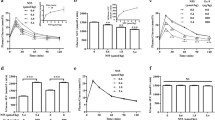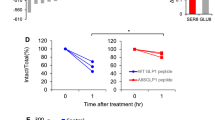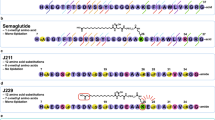Abstract
Glucagon-like peptide-1 (GLP-1) and gastric inhibitory polypeptide (GIP) have a similar but complementary role in regulating blood glucose level. This study was aimed to develop a functional-complementary dual insulinotropic peptide which releases both GLP-1 and GIP in vivo, and to investigate its therapeutic effect on type 2 diabetes in mice. We firstly constructed a vector pET-22b(+)-rolGG to express a recombinant oral long-acting GLP-1–GIP fusion peptide (rolGG) in E. coli. The rolGG peptide was then purified and confirmed its capacity of releasing recombinant oral long-acting GLP-1 (rolGLP-1) and recombinant GIP (rGIP) upon trypsin digestion in vitro, which were designed to resist in vivo enzymatic degradation. The therapeutic effect of rolGG was assessed in comparison with rolGLP-1 alone by daily oral-gavage administration up to 10 days in streptozotocin-induced type 2 diabetic mice. Saline and rosiglitazone administrations were served as negative and positive controls, respectively. The results showed that rolGG treatment decreased plasma glucose level by 26.7 and 46.3 % (p < 0.01), respectively, at 5 and 10 days after the initial oral-gavage. The rolGG treatment also led to a trend of body weight increase, drink level and food intake decrease (p < 0.05). In comparison, the oral administration of rolGLP-1 alone exhibited similar effects to rolGG with regard to plasma glucose level, drink level and food intake. In conclusion, we expressed and purified a dual insulinotropic peptide rolGG. Oral-gavage administration of rolGG showed a therapeutic effect on reduction of plasma glucose and alleviation of emaciation, polydipsia, and polyphagia symptoms in streptozotocin-induced diabetic mice.







Similar content being viewed by others
References
Baggio LL, Drucker DJ (2007) Biology of incretins: GLP-1 and GIP. Gastroenterology 132:2131–2157
Bell GI, Sanchez-pescador R, Laybourn PJ, Najarian RC (1983) Exonduplication and divergence in the human preproglucagon gene. Nature 304:368–371
Brown JC (1994) Enteroinsular axis. In: Dockray GJ, Walsh JH (eds) Gut peptides: biochemistry and physiology. Raven Press, New York, pp 765–784
Deacon CF, Wamberg S, Bie P, Hughes TE, Holst JJ (2002a) Preservation of active incretin hormones by inhibition of dipeptidyl peptidase IV suppresses meal-induced incretin secretion in dogs. Endocrinology 172:355–362
Deacon CF, Plamboeck A, Møller S, Holst JJ (2002b) GLP-1-(9-36) amide reduces blood glucose in anesthetized pigs by a mechanism that does not involve insulin secretion. Am J Physiol Endocrinol Metab 282:E873–E879
Frokjaer S, Otzen DE (2005) Protein drug stability: a formulation challenge. Nat Rev Drug Discov 4(4):298–306
Gault VA, Flatt PR, O’Harte FP (2003) Glucose-dependent insulinotropic polypeptide analogues and their therapeutic potential for the treatment of obesity-diabetes. Biochem Biophys Res Commun 308:207–213
Gautier JF, Fetim S, Sobngwi E, Salaün-Martin C (2005) Biological actions of the incretins GIP and GLP-1 and therapeutic perspectives in patients with type 2 diabetes. Diabetes Metab 31:233–242
Green BD, Mooney MH, Gault VA, Irwin N, Biley CJ, Harriott P, Greer B, Flatt PR, O′Harte FP (2004) Lys9 for Glu9 substitution in glucagon-like peptide-1(7-36) amide confers dipeptidylpeptidase IV resistance with cellular and metabolic actions similar to those of established antagonists glucagon-like peptide-1(9-36) amide and exendin(9-39). Metabolism 53:252–259
Green BD, Liu HK, McCluskey JT, Duffy NA, O’Harte FP, McClenaqhan NH, Flatt PR (2005) Function of a long-term, GLP-1 treated, insulin-secreting cell line is improved by preventing DPPIV mediated degradation of GLP-1. Diabetes Obes Metab 7:563–569
Hou J, Yan R, Yang L, Wu Z, Wang C, Ding D, Li N, Ma C, Li M (2007a) High-level expression of fusion protein containing 10 tandem repeated GLP-1 analogues in yeast Pichia pastoris and its biological activity in diabetic rats mode. Biosci Biotechnol Biochem 71(6):1462–1469
Hou J, Yan R, Ding D, Yang L, Wang C, Wu Z, Yu X, Li W, Li M (2007b) Oral administration of a fusion protein containing eight GLP-1 analogues produced in Escherichia coli BL21 (DE3) in streptozotocin-induced diabetic rats. Biotechnol Lett 29:1439–1446
Knudsen LB, Pridal L (1996) Glucagon-like peptide-1-(9-36) amide is a major metabolite of glucagon-like peptide-1-(7-36) amide after in vivo administration to dogs, and it acts as an antagonist on the pancreatic receptor. Eur J Pharmacol 318:429–435
Kreymann B, Williams G, Ghatei MA, Bloom SR (1987) Glucagon-like peptide-1 7-36:a physiological incretin in man. Lancet 2:1300–1303
Northrop JH, Kunitz, M (1931) Isolation of protein crystals possessing tryptic activity. Science 73:262–263
Pospisilik JA, Stafford SG, Demuth HU, Brownsey R, Parkhouse W, Fineqood DT, Mclntosh CH, Pederson RA (2002) Long-term treatment with the dipeptidyl peptidase IV inhibitor P32/98 causes sustained improvements in glucose tolerance, insulin sensitivity, hyperinsulinemia, and beta-cell glucoseresponsi-veness in VDF(fa/fa) Zucker rats. Diabetes 51:943–950
Shah RB, Ahsan F, Khan MA (2002) Oral delivery of proteins: progress and prognostication. Crit Rev Ther Drug Carrier Syst 19:135–169
Torchilin VP, Lukyanov AN (2003) Peptide and protein drug delivery to and into tumors: challenges and solutions. Drug Discov Today 8:259–266
Turton MD, O’Shea D, Gunn I, Beak SA, Edwards CM, Meeran K, Choi SJ, Taylor GM, Heath MM, Lambert PD, Wilding JP, Smith DM, Ghatei MA, Herbert J, Bloom SR (1996) A role for glucagon-like peptide-1 in the central regulation of feeding. Nature 379:69–72
Vahl TP, Paty BW, Fuller BD, Prigeon RL, D’Alessio DA (2003) Effects of GLP-1-(7-36)NH2, GLP-1-(7-37) and GLP-1-(9-36)NH2 on intravenous glucose tolerance and glucose-induced insulin secretion in healthy humans. J Clin Endocrinol Metab 88:1772–1779
Zhang M, Lv XY, Li J, Xu ZG, Chen L (2009) The characterization of high-fat diet and multiple low-dose streptozotocin induced type 2 diabetes rat model. Exp Diabetes Res 2008:704045
Acknowledgments
This study was supported by Project 863 of China (2008AA02Z205).
Author information
Authors and Affiliations
Corresponding authors
Rights and permissions
About this article
Cite this article
Zhang, Y., Wang, W., Wei, Y. et al. Construction of a Functional-Complementary Dual Insulinotropic Peptide rolGG and Its Therapeutic Effect on Type 2 Diabetes. Int J Pept Res Ther 18, 327–333 (2012). https://doi.org/10.1007/s10989-012-9305-0
Accepted:
Published:
Issue Date:
DOI: https://doi.org/10.1007/s10989-012-9305-0




